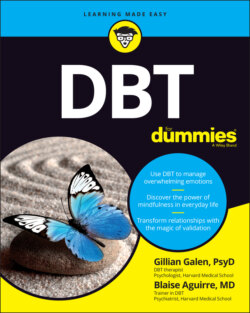Читать книгу DBT For Dummies - Gillian Galen - Страница 80
Recognizing How You’re Feeling
ОглавлениеThe first step to recognize how you’re feeling is to pay attention. However, for people who struggle with intense emotions, the urge is to do just the opposite. Instead of paying attention, they tend to do things to avoid their emotions. Emotional avoidance can take many forms, from distracting yourself and never returning to the feeling, to telling yourself you should not or cannot feel that way, to using alcohol or drugs, sex, reckless behaviors, self-injury, or even suicide.
If you can pay attention to what you’re feeling and shine a light on the experience, as challenging as it may be, it will actually begin the process of decreasing the intensity of that feeling. It’s a big ask, we know. Sometimes your emotions will be too intense to start observing; when that is the case, you’ll start by using distress tolerance skills (discussed in Chapter 11) to decrease the intensity of the emotion before looking more closely at how you’re feeling. It can be tempting to stop after using a distress tolerance skill, but when you do, you’re providing a short-term solution to get you through, but not creating any enduring change in how you feel.
In the following sections, you begin to see how paying attention and using mindfulness will help you get to know your emotions and give you the power to control them. Recognizing your emotions takes practice, but once you’re familiar with the process, you’ll find that you can easily integrate it into your life in a way that will support your use of all of the other DBT skills in this book.
